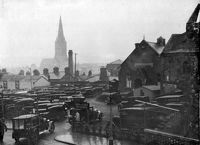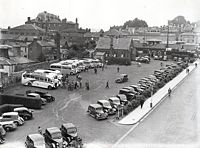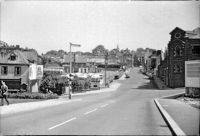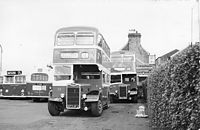
Paul Street Bus Station – 1929 to 1964
Page added 20 July 2014
Back to Transport
The 50th Anniversary of the opening of Exeter Bus Station at Paris Street was in July 2014; this one fact, puts memories of the old bus station at Paul Street from before the post baby boomer generation. Paul Street would serve as Exeter’s main bus station for a period of 34 years, coming into service on the demise of the old electric tram system.
After the First War, Exeter trams were in a poor state, having been starved of funds for maintenance and upgrades. Devon General buses were already serving routes between the city and other parts of Devon, and a makeshift terminus existed on a stretch of New North Road, near the Theatre Royal. Congestion increased when the City Council started a limited bus service, around the city, to supplement and act as a feeder to the trams, in April 1929. Increasing motor traffic, especially in the summer months, led to an increase in congestion. The need for a terminus for Devon General was urgent, and a site, at the top of Paul Street, which had recently been demolished, was leased, for 14 years, from the City Council on the 25 December 1930; I assume the city officials signed it before that date, so they could celebrate Christmas. A building on the site was converted into public lavatories, a booking and parcels office, cloakroom and left luggage office. A single entrance from Paul Street onto a suitable area of apron was available for the buses. Buses would pull in to disembark and load, and reverse out, amidst milling passengers and their luggage. The Exeter and Plymouth Gazette commented a year after opening:
“Visitors Exeter by long distance road coaches will find Paul-street parking place much more in keeping with the amenities of the city than was the case last summer. The place then was in a half-finished condition: now it has a much more inviting look. The waiting-rooms, cloak-rooms, etc., are finished, ornamental iron railings enclose the space and shrubs have been planted in front along the sides. Many of the shrubs are of flowering varieties, and by the time the great influx of visitors takes place, it should be a joy to the eye, and a welcome change from the old state of affairs. The lower part of Paul-street is still awaiting the time when it will be turned into a bus station. When that will be I do not know. At any rate, I hope it will not take so long to equip as did the conversion of the major part of Paul-street into a suitable parking place from a mass of condemned buildings.”
In May 1931, another comment in the Gazette charted the gradual improvements made to the facility:
“The improvements that are being effected at the Paul-street parking place, Exeter, are making this much-used adjunct to travelling facilities more in keeping with the importance of the city than was lately the case. The soft surface of the bus station—which became a quagmire in wet weather, and a dust-raising centre during dry periods—is being superseded by concrete paving, with adequate draining. A petrol filling station has also been installed. The reconstructed station will be of benefit both to drivers of buses and the travelling public. At the corner of Queen-street the new kiosk for the Exeter Official Information Bureau is rapidly taking shape. When completed this should prove a great asset to the city and visitors. It will catch the eyes of people from the railway stations, of private car drivers using the Paul-street parking place, and patrons of bus and long distance coach services. The approach to Paul-street will be much improved. Perhaps, in the course of time, arrangements may be made whereby the old malthouse, in the central parking space, can be replaced with waiting-rooms. At present it is an eyesore. Shrubs planted along the borders of the parking grounds are making good growth, and in another year should be an advantage in regard to the appearance of the parking places. The reconstructed bus station will be in use to-day.”
The site was cramped, and quickly becoming more congested as more bus services were introduced. During the 1930s, many car drivers who parked opposite the entrance to the bus station were summoned for obstruction, as buses, with a turning circle of 26ft, were prevented from leaving the station. In 1936, the entrance from the street was widened to 60ft: extra rooms were added between 1939 and 1946, while a staff rest room was made available from November 1939. There was a car park and coach, adjoining the bus station, lower down Paul Street, in the area of the present car park over Harlequins. Since the first opening of the bus station, there was a need of more bus parking, and in 1949, car park was leased for the use of buses, twenty years after the need was first envisioned.
Exeter Corporation buses started to use the bus station on a regular basis in 1947, under the Joint Services agreement. Occasional services from Plymouth, Barnstaple, Minehead and Weymouth, run by Western or Southern National used the Paul Street facility. The influx of tourists into Exeter was acknowledged by the City Council when they leased land on the corner of Paul and Queen Street, right next to the terminal, for an Information Bureau.
By the 1950s it was fast becoming apparent that the bus station was no longer fit for purpose. The approach roads were congested, with difficult a corner at the top of Paul Street, and it was becoming too small. The need for a new bus station became urgent when, on the 29 September 1959, the City Council served notice on Devon General to vacate the site. A short reprieve was negotiated, until new premises could be found. The Council leased a bomb site off Paris Street, and south of Sidwell Street, for a new bus station and coach park. Devon General moved out of Paul Street, into their new facility on 5 July 1964, and Paul Street became a car park once again. When the Guildhall Centre was developed, a car park was constructed on the top. An approach ramp from the old bus station site, that curved around and crossed Paul Street was constructed. The Harlequins Centre was built over the site in the 1980s, incorporating the approach ramp into the design, and adding more multi storey car parking. The Information Bureau moved to the Civic Centre, and all memories of Paul Street as an entrance to Exeter for bus and coach passengers were lost.
Sources: Exeter and Plymouth Gazette and Devon General by Leslie Fulkard.
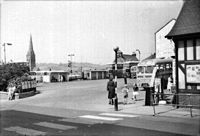
The bus station in the late 1950s - the Information Bureau is the timber framed building. Photo Dick Passmore.
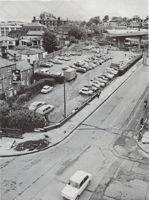
The ramp for the Guildhall Centre car park has been constructed in this photo from the 1970s. Harlequins is still to be built. Photo Dick Passmore.
│ Top of Page │
